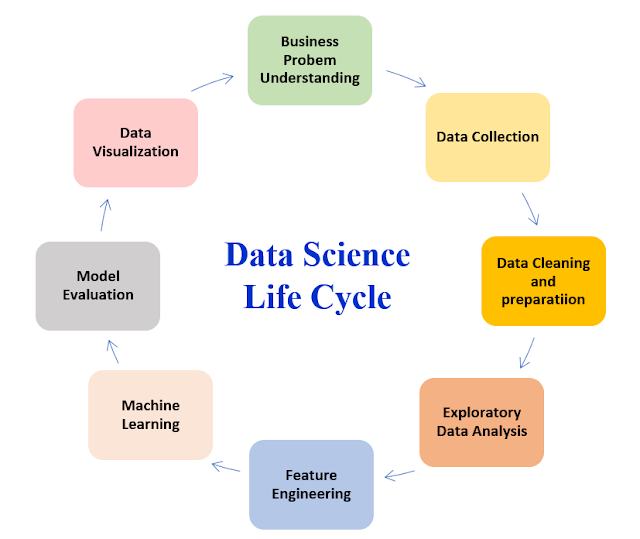
Understanding the Data Science Life Cycle
The Data Science Life Cycle is a process that encompasses stages, each essential in transforming raw data into actionable insights. This life cycle acts as a roadmap for data scientists, analysts, and professionals by providing an approach to harnessing the power of data.1. Problem Definition
At the core of any data science project lies a defined problem. During this stage, we collaborate closely with stakeholders to identify and understand the issue that needs addressing. Having a clear problem definition establishes a foundation for the life cycle ensuring that subsequent steps align, with overarching goals.2. Data Collection
Once we have crystallized the problem statement our next step is to gather data.This may involve gathering information from organized databases acquiring data, from sources or even using a combination of both. It is crucial to have a range of varied data, for precise and significant analysis. Therefore it is essential to adopt a thorough approach when collecting data.
3. Cleaning and Preparation of Data
Raw data is rarely ready for analysis. We concentrate on data cleaning and preparation during this period. This includes discovering and correcting discrepancies, coping with missing values, and converting data into an appropriate format. This phase consumes a large amount of a data scientist's time, as the quality of analysis is heavily dependent on the cleanliness of the data.4. EDA (Exploratory Data Analysis)
EDA is the step at which data comes to life. We investigate the data's patterns, correlations, and anomalies using various statistical and visual tools. This phase frequently yields significant ideas that assist in refining the problem definition and influence future analysis.5. Feature Development
To develop effective prediction models, feature engineering entails picking and manipulating the most relevant attributes from the dataset. Skillful feature engineering can considerably improve model performance and add to the project's overall success.Model Construction
Building predictive models is at the heart of data science. We create models that can effectively predict future outcomes or classify data points using algorithms such as regression, classification, clustering, and deep learning. In this phase, iterative experimentation with multiple models and settings is usual.7. Model Assessment
Once trained, models must be extensively evaluated. This stage entails evaluating the model's performance using relevant measures such as accuracy, precision, recall, F1-score, and others. Models that match established criteria advance to the next stage.8. Model Deployment
Putting the models into action is a vital step. The models are deployed by integrating them into the operating environment, making predictions based on new data, and measuring their performance over time. To guarantee a smooth transition, this phase necessitates collaboration with IT teams.9. Monitoring and upkeep
Data science projects are never finished; they require constant monitoring and upkeep. Models must adapt to shifting data patterns to remain relevant. Regular updates, retraining, and refining are required to keep the project running well.The Life Cycle of Data Science
The Data Science Life Cycle outlines a methodical way to gain insights that will help you make better decisions. Organizations that follow this full process can:Improve Decision-Making: Data-driven insights enable organizations to make strategic decisions that have a positive influence on different elements of their operations.
Uncover Opportunities: Thorough data analysis frequently reveals hidden opportunities, such as untapped markets or unique product directions.
Reduce Risks: By recognizing patterns and trends, data science may aid in risk assessment and management, ensuring organizations are better equipped to traverse uncertainty.
Process Optimisation: Data science can help to streamline processes, resulting in higher efficiency and lower operational costs.
Personalise Experiences: Using data insights, organizations may build personalized customer experiences that increase engagement and loyalty.



